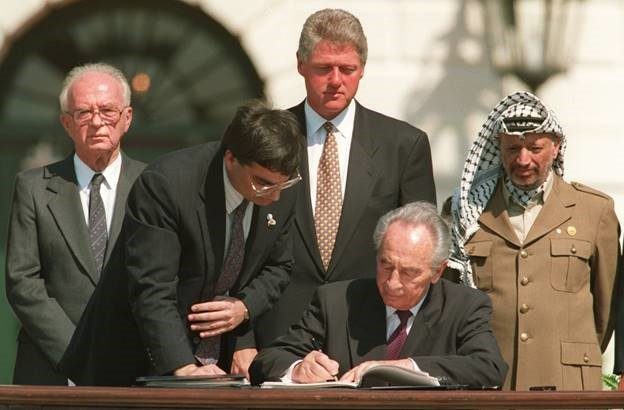
Joel Singer, Legal Affairs Adviser, Israel Ministry of Foreign Affairs
Ken Stein, introduction, June 24, 2021
Source: With the author’s express permission to present the article here
On September 9, 1993, four days before Yasser Arafat and Yitzhak Rabin signed the Oslo Accords on the White House Lawn, Israel and the PLO signed mutual recognition Letters. Joel Singer, who significantly assisted the negotiation of both the MRA and the Oslo Accords, as well as earlier agreements with Egypt, recalled that the MRA was “a massive leap forward in Israeli-Palestinian relations. Israel considered the PLO as a terrorist organization not worthy of recognition and the PLO considered Jews only as a religion, not a people and an artificial entity.” The recognition letters were diplomatically and philosophically linked to the Oslo Accords, itself aimed at achieving operational implementation of Palestinian self-rule concept. That Palestinian autonomy concept had been agreed upon by Israeli Prime Minster Begin and Egyptian President Sadat as part of the 1978 Camp David Accords. However, the Palestinian autonomy segment of the Camp David Accords were never implemented primarily because of disinterest on the part of Egypt, the US, Jordan, Israel, and Arafat’s Palestinian leadership.
In the 1993 MRA, the PLO agreed to renounce terrorism and accept Israel’s right to exist in peace and security. These were two demands that the international community had placed on the PLO before the PLO would be allowed to participate in a negotiating process. As early as 1977, President Carter had tried but failed to convince the PLO leadership to accept these conditions as entry into an American led negotiations that might go through the portal of an international conference. Arafat refused to participate. Fifteen years had passed without Palestinian-Israel talks unfolding into discussion that might have focused or changed on the future disposition of the West Bank, Gaza Strip, and portions of Jerusalem that Israel had held since its defensive war of June 1967. Without any discussions on the future disposition of these territories, except an Israeli promise not to apply its sovereignty to the territories, Israel used the time to place Jewish settlers in the territories along with building settlements. Lamenting the opportunity lost in 1978, then President Mubarak noted in 1992, the year before the MRA and the Oslo Accords, “We wish we had proceeded according to the Camp David Accords. There were few settlements or anything else at the time. Had the accords been implemented, settlements would not have been built. Today, 75 percent of the occupied territories are covered with settlements. We had them in our hands without settlements.” (Arab Republic of Egypt Radio Network, April 30, 1992, as quoted in Foreign Broadcast Information Service – Near East, May 1, 1992, pp. 14-15.)
In addition, in the MRA, the PLO recognized UN Security Council Resolutions 242 and 338 that spoke about the respect for territorial integrity of all states in the region and direct negotiations with Israel. Challenged by other Palestinian voices – those in the West Bank, Jerusalem, and the Gaza Strip and from Hamas, Arafat wanted Israel recognition that his PLO leadership and none other represented legitimate Palestinian representation. Moreover, Arafat in the implementation of the Oslo self-rule agreement wanted the PLO to be the exclusive Palestinian address.
While Yitzhak Rabin agreed to recognize the PLO as the sole legitimate representative of the Palestinian people with whom Israel would negotiate, but he did not recognize either Palestinian self-determination or promise to see the evolution of a Palestinian state. Rabin stated to Yehuda Avner, three days before his assassination in November 1995, that one of the reasons that he signed the Oslo Accords and the MRA was to bolster the secular element of the Palestinian movement over deep concern for the growing strength of Hamas with its Islamic orientation supplied with ideology and funding from Iran. Rabin believed Israel could withstand a clash of secular nationalisms (Israel and the Palestinians), but feared a clash for Israel versus a much larger and potentially more treacherous theological confrontation between the Jewish state and a radicalized Islamic world. The MRA ultimately served as a prelude to the historic Oslo process of 1993-95, which included other agreements about Palestinian self-rule. How the MRA were negotiated in tandem with the more detailed Oslo Accords is the subject of Singer’s excellent article. Joel Singer’s entire article, “The Israel-PLO Mutual Recognition Agreement,” may be found at International Negotiation 26 (2021), 1-25, or at: https://israeled.org/wp-content/uploads/2021/06/Mutual-Recognition-Final-pdf-Singer.pdf.
Ken Stein, June 24, 2021
